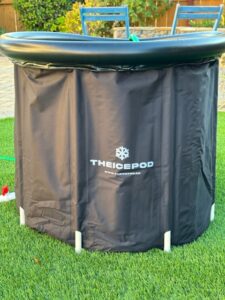There is no doubt about it. Ice baths are incredibly popular right now. This trend can be incredibly useful, if you are doing it properly and doing it for the right reasons.
I have been experimenting with ice baths and cold showers for a while and researching this topic to find the best way to utilize it. This post will hopefully help you get started or improve your use of ice baths.
Benefits are Ice Baths
There are a number of reasons why you might want to implement ice baths into your routine. We can look at this from a physiological and psychological standpoint.
Physiologically, ice baths are a huge stressor on the body. This is a point we will refer back to when we talk about implementing it. When you jump in cold water it will signal a sympathetic response initially. Blood with move away from your skin and towards your organs to protect them. You core temperature will obviously be lowered. Too cold for too long can have damaging effects on the body. But short exposures in reasonable temperatures can help reduce inflammation and promote the immune system.
When performing an ice bath right after a workout can it also have potential benefits as well. As mentioned inflammation will be reduced and there has been evidence that it can lead to faster recovery from a workout by reducing muscle soreness, perceived exertion, and markers of muscle damage. After endurance training there has been evidence that it may increase activation of gene that increase mitochondria which will help boost endurance performance.
On they psychological side there are also many benefits. Getting in cold water sucks. It is not easy to do. Any time we do things that are hard, there is an improvement in mental resiliency. There is a good chance that will toughness will carry over into different aspect of life.
While it may suck to get into an ice bath, it feels amazing afterword. Like a workout for many, it is really tough to get through it, but most feel awesome when they are done. The increase in endorphins makes us feel better. Initially we have that sympathetic response, but after the body will bounce back with an increase parasympathetic response helping us relax and recovery.
Why Take An Ice Bath?
So the next questions we should ask are do you need to take an ice bath and why are you doing it? If you are looking for ways to recovery better, will an ice bath help you? The first question I ask, is are you training hard enough to need an advanced recovery method like this? If you aren’t training hard, there are other, much easier ways to focus on recovery. This tool should be used after more intense training sessions.
If you are using them for more of the psychological benefits, then there is more of a justification to use it despite the type of training you are doing.
If you are using it as a recovery tool and you are training hard, then we have to look at what type of recovery are you looking for. As mentioned there are some great physiological benefits jumping in an ice bath right after training. The biggest issue though depending on your goal, these benefits may backfire. If your primary goal of training is muscle strength and size, you need inflammatory markers to increase to promote an appropriate response. This inflammation leads to bigger, stronger muscles. If you reduce that signal you reduce your results. This doesn’t mean you can’t take ice baths if your goal is bigger muscles, but you should avoid doing them right after your workout.
If your primary goal is to bounce back as quickly as possible for another training session or event, then go for it. Maybe you are racing back to back days and need to recover after your first race. Ice baths are a great option. Since you don’t care about adaptations from training and more about being able to perform again, then you want to take advantage of these benefits.
How To Take Ice Baths
 Step one is the logistics. Ice baths aren’t always the easiest to set up. There are many products out there you can purchase for home use. Some can get really expensive. One of my latest partners is The Pod Company and their IcePod Pro has made home ice plunges incredible easy and affordable. There are some other products out there, but I personally use this one and can vouch for how easy it is to set up and use. Check it out here and save $10.
Step one is the logistics. Ice baths aren’t always the easiest to set up. There are many products out there you can purchase for home use. Some can get really expensive. One of my latest partners is The Pod Company and their IcePod Pro has made home ice plunges incredible easy and affordable. There are some other products out there, but I personally use this one and can vouch for how easy it is to set up and use. Check it out here and save $10.
Once you have your ice bath it is time to get in. Most research uses temperatures from around 54-57 degree F and will last from 10-15 minutes. The colder the water is, the shorter your time will be in there. The warmer water you can stay in longer. More is not always better. Remember there are negative effects of getting your body too cold.
If you performed strength training, it is ideal to either not plunge right after training or just wait until the next day. Hours after your training will probably be ok to get in, but if you are in doubt, just wait until the following day to use it. If you are doing endurance training jump in. Ice baths may enhance the training effect and lead to better performance.
Once you are in there, use this time to focus on your breathing. It is not comfortable being in there. Use your breath to focus your energy on remaining calm and dealing with the cold. The more you do it the better you will get.
The final piece you may not like. Move around a little or move the water around. As you sit still, heat will surround your body keeping the water there warmer. Remember we are trying to drop our core temperature, so move a little to keep that cold exposure going.
I hope this helps in your journey to faster recover and better resilience. Don’t forget to check out the Pod Company and there super easy to use portable ice bath.
Mike Deibler
OCR Underground

